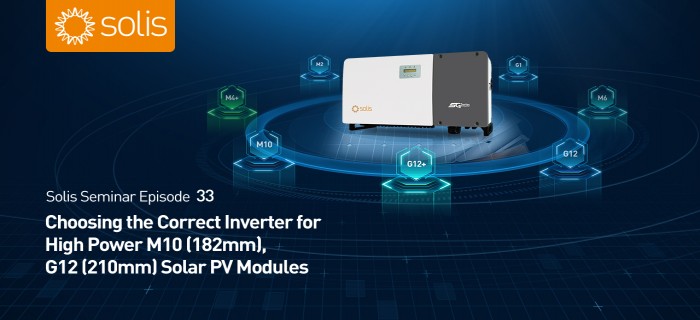
Solis Seminar Episode 33: Choosing the Correct Inverter for High Power M10 (182mm), G12 (210mm) Solar PV Modules
Background
Over the past few decades, mainly due to advances in technology and reduction in cost, the size of silicon wafers used in solar modules has evolved from an early stage 125mm to the current standard M6 (166mm), M10 (182mm) and G12 (210mm). What impact do these larger modules have on related equipment? What should be considered when designing a system with these modules? What are the impacts between high-current components and inverters?
In this Solis seminar, we will look at these so called “high-power” modules in more detail and compare them using actual operating conditions.
Features of M10, G12 PV Modules
Since the output current of a solar module is related to its area, the larger the area, the greater the output current.. Looking at picture 1 below, a datasheet for a 530 - 550W M10 (182mm) solar module range, the output current of the module under normal working conditions is less than 15A; and for high irradiance areas, in the case of high ground reflectivity, the 182mm silicon cell module may reach 15A, whereas for a G12 (210mm) module, the current will exceed 15A as shown in Picture 2.
Picture 1: M10 (182mm) PV panel datasheet
Picture 2: G12(210mm) PV panel datasheet
Compatibility of the Inverter
The DC side of the inverter has certain restrictions on the current connected to the string. For traditional string inverters, the maximum current of each string is 12.5A. In most application scenarios, standard M6 (166mm) solar modules are operating under normal working conditions. The output current is less than 12.5A, therefore the traditional inverter and M6 components are adapted and compatible.
The current of M10 and G12 modules is greater than 12.5A, so the current limit risk brought by a non-compatible inverter is increased, especially when irradiance exceeds 800W/m2. The output current of the string will exceed the allowable input current of the inverter, which will cause losses in efficiency due to the inverter not being able to adapt to the incoming power.
It is essential that inverters developed for use with high-power modules are selected when designing a system with these types of modules.
Solis Inverters – Compatible with High Power Modules
Solis inverters have been upgraded across the full range from small residential all the way up to utility scale. The maximum MPPT current can reach 32A, which matches the needs of high-current PV modules.
For example, looking at the datasheet below, the Solis 3 phase 10kW inverter has a max. input current of 2*16A or 16A per MPPT
Simulation of a Working Scenario – Solis v’s “A N Other” inverter
For both systems we chose 210mm modules with a power of 550Wp; in the same external environment, run for 1 day to verify their adaptability.
In the first system we used Solis 3 phase 10kW inverters with 16A string input current.
In the second system we used a 10kW inverter from an other manufacturer with 12.5A string input current.
Test Results
After completing a comparison test, we exported the string current output data from the monitoring software.
Solis Inverter with 16A input current
Using an inverter with 2*16A MPPT input current the string current (green), voltage (blue), and power output (red) are as shown in the graph below.
What can be seen is when there is high irradiance, the PV module current exceeds 15A, and is close to 16.3A. Due to the inverter compatibility string current is not limited and power generation is maximized.
A N Other Inverter with 12.5A input current
Using an inverter with 12.5A MPPT input current the string current (green), voltage (blue), and power output (red) are as shown in the graph below.
In the same situation when there is high irradiance and the PV module current reaches 16.3A. the string current is limited by the inverter at 12.5A. Power generation of the module is not maximized and is limited to the operating capacity of the inverter.
Conclusion
In the experiment, 210mm G12 modules were used, and the DC side installed capacity of a single inverter was 13.2kW. When using the 12.5A inverter, the loss caused by the inverter DC side current limit was 6.16kWh, which equates to close to 14% power loss.
When using a 16A input current inverter model, there are no losses caused by the inverter's DC side current limit.
At the same time, the inverter with a greater current input has smaller losses from overload and current limiting.
Summary
For 210mm G12 modules, there is a sizable amount of current limit power loss when using a 12.5A inverter.
It is more appropriate and advisable to choose a single string of 16A or install more inverters. Of course, you could also use an inverter with an MPPT input current of more than 16A. For 182mm components, the current carrying capacity of the 16A input current inverter is more than sufficient.
Solis’ upgraded inverters with higher input currents are compatible with all high power and bifacial modules. Choosing Solis means that you will always be maximizing the power generating potential of your high-power modules.
If you have any other questions, you can contact your local Solis support team at:
www.solisinverters.com
Solis is one of the world's largest and most experienced string inverter manufacturers with a global network of service teams

.gif)
.jpeg)
leave your comment